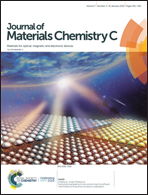A naturally-derived supramolecular elastomer containing green-synthesized silver nanofibers for self-repairing E-skin sensor†
Abstract
Despite the wide range of applications of flexible strain sensors, most of them use covalently crosslinked elastomers as a stretchable matrix, which may cause potential environmental problems via the disposal of worn-out devices. To mitigate this environmental threat, endowing sensors with self-repairability can be a simple and effective way to prolong their service lives. However, most current self-repairing sensors require complicated syntheses, in which hazardous solvents and reagents are always needed. Therefore, it remains challenging to develop an environment-friendly self-repairing sensor. Here, we report a sustainable self-repairing strain sensor based on naturally-derived supramolecular elastomer and green-synthesized silver nanofibers. This E-skin sensor features a high conductivity (≥104 S m−1), low percolation threshold (0.32%), high sensitivity (gauge factor ∼405.6) and desirable real-time (≤30 s) self-repairability after damage. This work may pave the way for the development of renewable, biocompatible and self-repairing next-generation wearable electronic devices.



 Please wait while we load your content...
Please wait while we load your content...